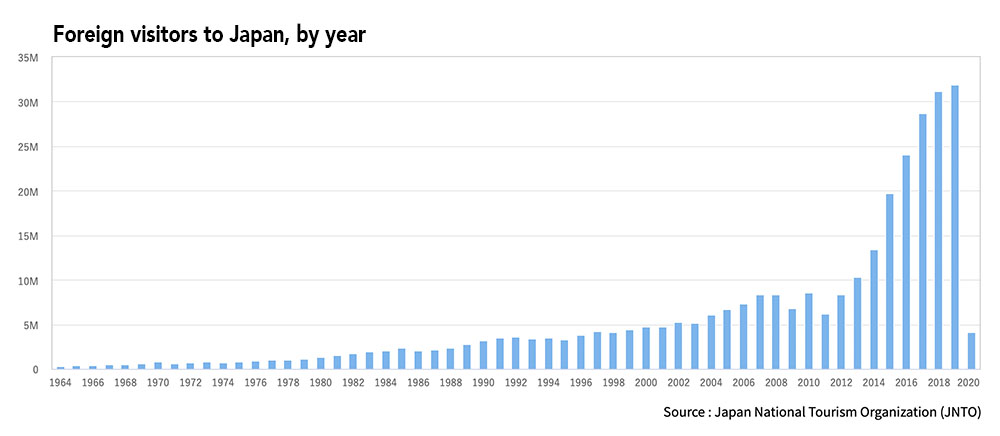You may have seen our recent announcement that we’re representing Japan’s Ibaraki Prefecture, to help encourage western companies to do business in the region. In this blog, I explore the history of one of Japan’s lesser-known regions, and why it could be the perfect location for your first business activities in the Far East – especially for businesses with an R&D focus, and those in the life sciences and medical industries ...
Before the COVID-19 pandemic, with the Tokyo 2020 Olympics on the horizon, the number of foreign visitors to Japan was surging to record levels. In 2019 alone, a whopping 31.88 million people visited the country – almost five times the number of visitors seen as recently as 2011.

Yet despite this enormous rise in foreign travellers, most visitors to Japan barely scratch the surface. Tourists and business travellers alike will be familiar with Tokyo, Kyoto, and Osaka for obvious reasons – but these three cities together account for less than 20% of Japan’s overall population, and there are entire cities and ecosystems throughout the rest of the country that many foreigners are simply unaware of. So, if you want to start doing business in Japan, where on earth should you look first?
An introduction to Ibaraki Prefecture
If you were among the 100+ million people to visit Japan in the last five years, the chances are that you flew right over Ibaraki Prefecture before landing at Narita airport. Sitting just to the northeast of Tokyo, the region is famed as Japan’s number-one producer and consumer of natto (fermented soybeans). It’s also home to one of the world’s biggest Buddha statues, and to the highest bungee jump in all of Japan (100m high!).

Three photos from my last visit to Ibaraki, August 2019
More importantly, however, Ibaraki packs some serious punch when it comes to industry and R&D. The prefecture boasts one of the nation's leading industrial clusters in Hitachi City, the birthplace of – you guessed it – Hitachi Ltd. And in the lush greenery of the foothills of Mount Tsukuba (one of the most famous mountains in Kanto, after Mount Fuji), sits the sprawling, vibrant R&D hub of Tsukuba Science City.
Home to over 20,000 researchers and students, Tsukuba contains the densest accumulation of science technology in all of Japan. It’s home to more than 30% of the nation's research and education facilities, and is the location for JAXA – the Japan Aerospace Exploration Agency, Japan’s equivalent of NASA. The city has also created four Nobel-Prize winners and, in 2019, hosted a G20 Ministerial Meeting on Trade and Digital Economy.
How did Tsukuba Science City come to be?
Looking at the greenery in some of the photos I've posted above, it may be something of a surprise that so much of Japan’s scientific capability is concentrated in an area like this. But, in reality, the city was specifically planned this way over the course of several decades.
In fact, the original concept for ‘Tsukuba Science City’ was first conceived by the Japanese government way back in 1963 as a means of consolidating and stimulating scientific discovery in Japan – whilst simultaneously easing overcrowding in nearby Tokyo. In preparation for the first Tokyo Olympic Games in 1964, Japan saw a host of huge urban regeneration initiatives like this, with the Olympics also to thank for the creation of Japan's first ever shinkansen bullet train.
Throughout the 1970s and 80s, as many as 43 research and educational institutions were relocated to the region – and thanks to these vast efforts, nearly half of Japan’s public research and development budget is spent in Tsukuba every year.

The International Exposition (1985), and a G20 Ministerial Meeting in Tsukuba (2019)
The city has subsequently been the birthplace of a host of important scientific breakthroughs by its researchers – including the identification and specification of the molecular structure of superconducting materials, the development of organic optical films that alter their electrical conductivity in response to changing light, the world’s first wearable ‘cyborg’ exoskeleton, and more. And with Japan rising to 13th in the WIPO global innovation rankings for 2020, these innovations are set continue.
So, why should you consider Tsukuba?
With all the above in mind, when it comes to setting up in Japan to access cutting-edge research, relevant partners, and funding – there’s really no competition. And both Ibaraki Prefecture and Tsukuba are trying to make the decision even easier, providing a host of incentives to attract many more foreign businesses and researchers to the region.
These incentives range from visa sponsorships to grants and business matching services – and even special housing for overseas researchers. There is also special support provided for overseas employees living in Tsukuba, including Japanese language classes, cultural events, and more...
So, if you’re interested in discussing the incentives for doing business of any kind in Ibaraki Prefecture, please don’t hesitate to get in touch at jack.porter@intralinkgroup.com